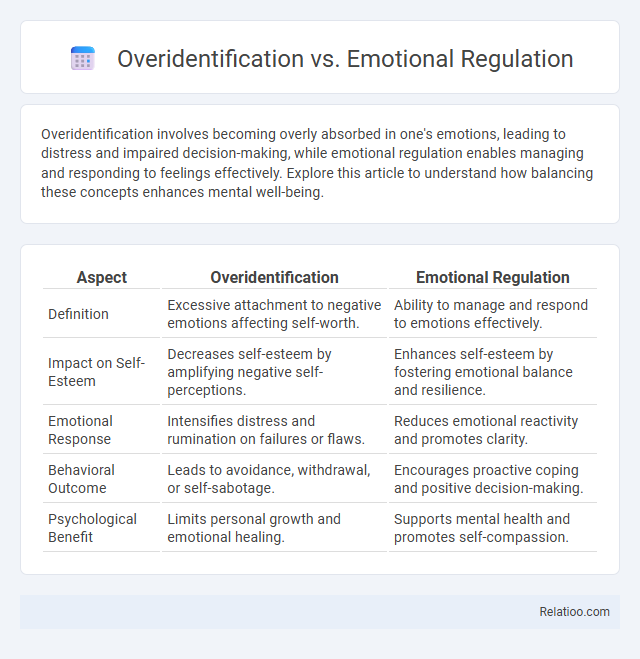Overidentification involves becoming overly absorbed in one's emotions, leading to distress and impaired decision-making, while emotional regulation enables managing and responding to feelings effectively. Explore this article to understand how balancing these concepts enhances mental well-being.
Table of Comparison
| Aspect | Overidentification | Emotional Regulation |
|---|---|---|
| Definition | Excessive attachment to negative emotions affecting self-worth. | Ability to manage and respond to emotions effectively. |
| Impact on Self-Esteem | Decreases self-esteem by amplifying negative self-perceptions. | Enhances self-esteem by fostering emotional balance and resilience. |
| Emotional Response | Intensifies distress and rumination on failures or flaws. | Reduces emotional reactivity and promotes clarity. |
| Behavioral Outcome | Leads to avoidance, withdrawal, or self-sabotage. | Encourages proactive coping and positive decision-making. |
| Psychological Benefit | Limits personal growth and emotional healing. | Supports mental health and promotes self-compassion. |
Understanding Overidentification: Definition and Impact
Overidentification occurs when individuals excessively fuse their identity with their emotions, leading to difficulty in maintaining emotional regulation and perspective. This intense attachment to emotional experiences can amplify negative feelings and hinder adaptive coping mechanisms. Understanding overidentification is crucial for developing strategies that promote emotional regulation and psychological resilience.
What is Emotional Regulation? Core Concepts Explained
Emotional regulation is the ability to manage and respond to emotional experiences in a healthy and adaptive way, allowing you to maintain emotional balance without being overwhelmed. It involves recognizing, understanding, and modifying your emotional reactions instead of becoming overidentified with those feelings or suppressing them entirely. Effective emotional regulation enhances resilience, decision-making, and interpersonal relationships by fostering awareness and control over your emotional responses.
Overidentification vs Emotional Regulation: Key Distinctions
Overidentification involves becoming excessively entangled in negative emotions, leading to a loss of perspective and heightened emotional distress, whereas emotional regulation refers to the ability to manage and respond to emotions in a healthy, balanced way. You can improve emotional regulation by practicing mindfulness, cognitive reappraisal, and stress-reduction techniques that help prevent the overwhelming effects of overidentification. Understanding these key distinctions is crucial for developing resilience and maintaining mental well-being.
Psychological Effects of Overidentification
Overidentification involves excessively merging your identity with negative emotions, leading to impaired emotional regulation and increased psychological distress such as anxiety and depression. This maladaptive process disrupts your ability to detach from harmful thoughts, exacerbating emotional turmoil and reducing mental resilience. Effective emotional regulation strategies can counteract these effects by fostering awareness and intentional control over your emotional responses.
Benefits of Practicing Emotional Regulation
Practicing emotional regulation enhances your ability to manage intense feelings without becoming overwhelmed by overidentification, which involves losing oneself in emotions. Effective emotional regulation supports mental clarity and resilience, promoting healthier responses to stress and reducing emotional reactivity. This skill fosters emotional balance, enabling you to navigate challenging situations with greater stability and self-awareness.
Common Triggers for Overidentification
Common triggers for overidentification include negative self-talk, unresolved trauma, and intense emotional experiences that cause you to merge your identity with your feelings. Unlike emotional regulation, which involves managing and responding to emotions effectively, overidentification leads to excessive attachment to emotions, making it difficult to maintain objectivity. Recognizing these triggers helps in developing healthier emotional boundaries and improving overall emotional well-being.
Strategies to Shift from Overidentification to Emotional Regulation
Strategies to shift from overidentification to emotional regulation include practicing mindfulness to observe emotions without judgment and implementing cognitive reframing techniques to alter negative thought patterns. Engaging in grounding exercises helps create distance from overwhelming feelings, allowing individuals to respond thoughtfully rather than react impulsively. Developing skills such as deep breathing and self-compassion fosters emotional resilience and a balanced perspective.
The Role of Mindfulness in Emotional Balance
Mindfulness enhances emotional regulation by fostering awareness of your thoughts and feelings without overidentification, which prevents you from becoming overwhelmed by negative emotions. This practice helps create a balanced perspective, allowing you to observe emotions as transient experiences rather than fixed realities. Cultivating mindfulness strengthens emotional resilience, supporting healthier responses and reducing the impact of overidentification on mental well-being.
Overcoming Overidentification: Practical Techniques
Overcoming overidentification requires cultivating emotional regulation skills that allow you to observe your feelings without becoming overwhelmed or lost in them. Techniques such as mindfulness meditation, cognitive restructuring, and grounding exercises help create mental space to respond thoughtfully rather than react impulsively. Developing these practices empowers your ability to maintain clarity and balance amid intense emotions, reducing the impact of overidentification on your mental well-being.
Building Long-Term Emotional Resilience
Overidentification involves excessively merging with negative emotions, leading to amplified stress, whereas emotional regulation enables awareness and management of feelings to maintain balance. Developing long-term emotional resilience hinges on cultivating regulation skills that prevent overidentification, allowing individuals to respond adaptively to challenges. Consistent practice of mindfulness and cognitive reframing strengthens neural pathways associated with emotional control, promoting sustained psychological well-being.

Infographic: Overidentification vs Emotional Regulation
 relatioo.com
relatioo.com